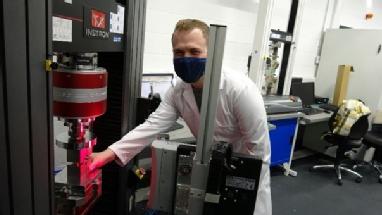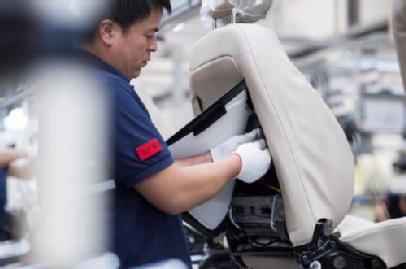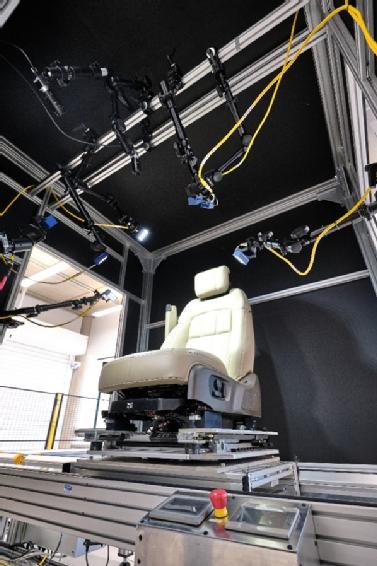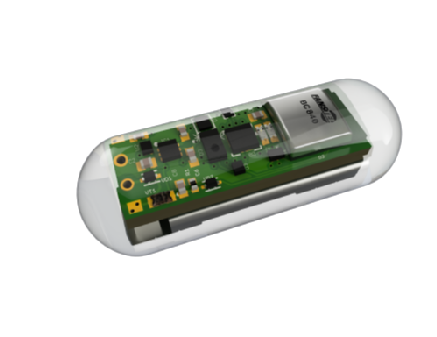Success Story Assetbank
Digital solutions leave seat manufacturer sitting pretty
Car manufacturing in the UK is changing radically, as the electrification is forcing innovation and design change of almost all parts of cars. Industry leaders are challenged to change design radically, launch new products more quickly, while maintaining quality levels and costs. To keep up with this, many manufacturers in the supply chain are already embracing digital technologies to connect their factories, improve processes and reduce costs. By embracing digitalisation, the electrification of the automotive sector could unlock growth of up to £75bn by 2035, benefitting the entire supply chain.
Using digital to develop manufacturing
Lear Corporation are a leading supplier of automotive seats and electrical systems, and their customers include major OEMs such as Jaguar Land Rover. With a long history in luxury and performance seating, they are one of the world’s largest providers of premium automotive leather seats, operating over 250 facilities across 38 countries, including 3 Just in Time final assembly plants here in the UK.

With safety and performance paramount, Lear must ensure that every seat is of the highest quality but working with comfort materials, such as foam, and natural materials, such as leather, brings with it a number of challenges. Not least, the natural defects that occur in these materials, such as wrinkles and discolouration, which must be rectified before products are ready for the customer.

Back in 2017, Andrew Williams, Director, Process Innovation at Lear Corporation was looking for ways to deploy digital technology to improve their seat inspection process, reducing waste and rework. “Seat inspection takes place at the end of the production line, and it’s a manual process which relies on the judgement of experienced operatives,” Andrew said. “But ultimately, it is subjective, we set our standards very high to protect our customer but human judgement will always have an element of variation.”

Lear wanted to innovate and deploy smart manufacturing solutions that would automate the inspection process, providing increased consistency and generating quantitative product data to the engineers in our relentless pursuit of perfect quality. Lear approached WMG as a market study showed a lack of readily available commercial and deployable solution that suited Lear’s needs at that time.
“We already had a relationship with WMG with apprentice, undergraduate and post graduate training programs. Lear’s philosophy is to constantly look for ways to use new technology to improve manufacturing processes and knowing WMG were all about industry-focused research, we knew they would be a good fit for this challenge.”
Andrew teamed up with our Automation Systems Group on the Lear Seat Manufacturing (LSM) project, supported by funding from WMG Centre HVM Catapult.
Exploring the possibilities
After scoping the project carefully, WMG set about building and testing machine learning-based object detection systems as an inspection tool; Using image capture systems mounted on a seat inspection station, the solution would be capable of detecting and classifying defects, and of assessing whether the seat would be acceptable against the customer standards, or whether additional rework is needed.
Developing the solution and training the AI, involved manually labelling a large data set. To facilitate this process, the team developed a “digital marker” that allows an in-line, in-process labelling workflow.
Dr Dan Vera, Associate Professor at WMG, said: “To train the AI inspection system, you need to tell it what defects are and what they look like. You have to label defects so it learns. Typically, labelling is done offline, after images are captured. With the labelling system developed at WMG, operators can digitally label defects on the real seat, and directly on the production line – we call it the magic wand!”
In order to test how the different elements would work together in a real manufacturing environment, we installed a prototype inspection station in the National Automotive Innovation Centre (NAIC) at WMG before taking the station into Lear’s plants for evaluation in production.

Looking to the future
The machine-learning seat inspection software was trialled at two of their factory sites, allowing it to collect data from different types of seat and improve its ability to recognise and categorise all types of defect. It is now on track to deploy across our plants worldwide.
Andrew said that without the help of the team at WMG, supported by funding from HVM Catapult and Innovate UK, they might have missed this opportunity. “This was unchartered territory,” he reflects. “Because this technology was so new, and there were no commercially available solutions at the time, we would not have had the bandwidth to develop this in house. The cumulative effect of these projects has the potential to significantly increase the consistency of our inspection processes and provide our customer with even higher quality products.”
Lear has showcased the test bed in NAIC to some of their key customers, who have been impressed with the outcomes of their work. There is a continued appetite within Lear to develop new ways to use digital technology to improve their manufacturing processes.
For more information about this project, or working with us, please email wmgbusiness@warwick.ac.uk.
New lab ‘must-have’ wireless sensor stirs up new opportunities for data collection
Challenge
Manufacturing novel advanced materials, polymers, and medicines push innovation forward and help to solve problems of health, pollution, security, and clean energy. The discovery of innovative products often requires a vision backed up with months and years of routine work. The human is crucial in generating the vision; but the human factor can cause errors, irreproducibility, and side-track the discovery in routine work. The past pandemic and lockdown have delayed innovation and laboratory research. A slowing economy decreases R&D investment, which further puts downward pressure on future economic growth and risks undermining the UK's leading position in materials discovery and innovation.
Monitoring of process parameters is a necessary part of modern production systems, mechanical engineering and science. With the increasing complexity of processes in today's industry, information gathering, and data acquisition can also become more complex using multiple instruments, increasing the project's overall cost. Data collection can be done in various ways, and WMG at the University of Warwick wanted to offer an innovative multi-sensor wireless data acquisition tool that can be deployed across industries to improve manufacturing accuracy and efficiency.
Solution
The researcher, Dr Dmitry Isakov, an Assistant Professor at WMG and his team developed and tested the device (called Smart Stirrer) that comprises a multi-functional sensor system, midrange Bluetooth module and System on Chip (SoC) and protecting housing manufactured in the form of a conventional magnetic stirrer bar. The team recognised that magnetic stirrers could be the best vehicle for a sensor that captures multiple parameters. Through a series of experiments, it has been demonstrated the performance of the Smart Stirrer capable of accurate in-situ monitoring of the physical properties of the chemical reaction, such as temperature, conductivity, visible-light spectrum, opaqueness, and viscosity. A prototype with components cost < £35 has demonstrated excellent work in laboratory conditions when conducting titration and oscillation reactions.
The functionality of the Smart Stirrer is implemented using open-source code in accordance with the user's needs. The team is currently working on the implementation of the Smart Stirrer into the IoT platform thus enabling even further to extend the application of the device.

Impact
Using an array of sensors combined with a low-cost wireless transmitter, all in a small chemically resistant package creates a powerful measuring device placed in-situ into the reactor and operating in conjunction with data storage on the cloud. The data processing by machine learning algorithms will facilitate the task of reproducibility of results and reduce the influence of the human factor. The feedback system will simplify this task using software algorithms and robotizing the production process.
Dmitry Isakov, WMG, commented, “The beauty of the Smart Stirrer is that it can be used everywhere, such as a sealed vessels thus minimising the contamination of the reactor. It may give a push to new discoveries as well. It is easy to integrate the stirrer into the labware family and make it “speak” to other lab equipment.”
Samuel Baldwin, from the Mathematics institute at the University of Warwick worked on the smart stirrer during his WMG summer internship, he added: “We have leveraged state-of-the-art technology to build a device with very low power consumption, a broad range of sensor capabilities, and high data-throughput over the Bluetooth Low Energy platform.
The laboratory of the future is that of automation, reproducibility, and safety; our all-in-one Smart Stirrer device eliminates the need for a vast array of individual wired sensors whilst maintaining the control and customisability that one would expect from any piece of advanced laboratory equipment. I look forward to seeing the Smart Stirrer solve laboratory problems and help us understand complex reactions.”
The Smart Stirrer can be an essential element in the future digital laboratory platform – a concept currently developed by the team. Digital laboratory would allow interaction with laboratory equipment (hot plates, switches, pumps) using single-board computers making such equipment “smart” by replacing the manual control with electronic (while using the same manual equipment). Such a platform will provide an unprecedented level of detail and enable monitoring of experimental tasks remotely, thus contributing to the continuation of progress in innovation and research.
The future of this project is to gain further insights into how this product can benefit end-users. The product is currently available for lease and will be available for purchase in the future. The team are keen to learn to more about improving the product for machine learning and to create the most useful device. For more information, email wmgbusiness@warwick.ac.uk.
Nikolay Cherkasov*, Samuel Baldwin, Gregory J. Gibbons, and Dmitry Isakov*
